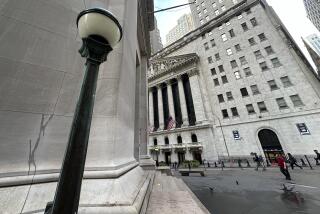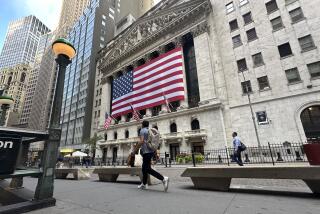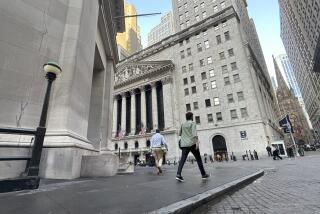MARKET BEAT : Now That Dowâs at 3,000, Where Will It Go Next? : Stocks: Many analysts see a 3,100 to 3,200 peak. The most optimistic say 3,800 or 3,900.
Now that the Dow Jones industrial average has rallied convincingly over 3,000, investment strategists are placing their bets on the next target level for the blue-chip index.
Most experts believe that 3,100 to 3,200 is likely to be the peak for the summer rally. If that doesnât seem like much of a gain from the Dowâs record Friday close of 3,027.50, well--it isnât:
* If the Dow tops out at 3,100, it will rise only another 2.4%. Thatâs $1.25 on a $50 stock.
* Even if the index makes it to 3,200, thatâs just 5.7% above Fridayâs close, or a little more than one-third of what the Dow has already gained year-to-date.
Makes you wonder if these highly paid Wall Street analysts are losing sight of some simple math: At the Dowâs current heights, 100-point increments arenât what they used to be. At 2,000, a 100-point rise in the Dow was a 5% move. At 3,000, 100 points is just 3.3%.
The higher you go, the less it takes to blow through 100 points like so much whipped cream. Which suggests that analysts may be underestimating the Dowâs potential in this rally.
Dow expectations are important because the 30-stock index has recently regained its crown as the market leader. After lagging smaller stocks since January, the Dowâs big-name stocks jumped an average of 4.8% in May, best of all major stock indexes.
Thus, more analysts and investors are looking to the Dow for guidance on the overall market trend this summer.
Is a 3,200 summer peak too low for a market that is showing as much momentum as this one? After all, New York Stock Exchange volume topped 230 million shares both Thursday and Friday, as the Dow rose 30.86 points and 27.05 points, respectively.
Wall Street hasnât seen two back-to-back 230-million-plus volume days in a rising market since early February, when the Dow ran from 2,740 to 2,940, a 7.3% gain, almost without interruption.
David Holt, technical analyst at Wedbush Morgan Securities in Los Angeles, is one of those market seers whoâs sticking with 3,150 as his summer-rally peak, despite the marketâs apparent momentum. âIâm not convinced that this is the real start of something,â Holt says.
Instead, he believes that investors will quickly begin to reconsider the prices theyâre being forced to pay for stocks now, relative to earnings expectations. Already, the average stock in the Standard & Poorâs 500 index trades for 17 times estimated 1991 earnings per share. Historically, a price-to-earnings figure of 18 has marked most market tops.
âIâm not sure thereâs enough merchandise out there that is fairly valued for investors to part with their cash,â Holt says.
Another expert who sees a summer peak of 3,150 to 3,200 on the Dow is Stan Weinstein, editor of the Professional Tape Reader newsletter and Global Trend Alert in Hollywood, Fla.
Weinstein bases his peak forecast on what he calls the âswing ruleâ for the Dow: When the index rallies strongly, drops sharply, then quickly rallies again, you take the number of points from the previous peak to the recent low, and add them to the current Dow. That often gives you your next peak.
The Dow jumped to an intra-day high of about 3,020 in mid-April, then fell as low as 2,840 in mid-May. That was a difference of 180 points. After the Dow crossed 3,020 again last week, the swing rule dictated that the next peak should be 3,020 plus 180, or about 3,200, Weinstein says.
But he advises investors to forget the Dow itself, because focusing on that single number understates the potential in the best stocks within the index. A Dow of 3,200 may be just 5.7% away from current levels, but some stocks are going to do substantially better, Weinstein notes.
Which stocks? âThe cyclical stocks are what I think the summer is going to be all about,â he says. Heâs advising clients to buy big-name stocks in only eight industry groups: Aluminum, autos, chemicals, forest products, paper, railroads, retail and steel.
Weinstein, a âtechnicalâ analyst who concerns himself more with the marketâs inner workings than with earnings trends or other fundamentals, argues that the cyclical industrial stocks are set to lead the summer rally no matter what the economic backdrop.
Investors may not be totally convinced that the recession is over or that industrial companiesâ earnings are going to be all that great any time soon. But the fact is, money now wants to come into these stocks, Weinstein says. And thereâs no use trying to stand in front of that kind of freight train.
âWeâre seeing tremendous positive money flows into these stocks,â he says. Though industrial stocks have rallied on other occasions in recent years, only to quickly fade, âthe probabilities are that this is not a false start,â Weinstein argues.
Overall, is it worth buying stocks at this juncture just for a summer gain? If youâre a fantastic trader (not to mention stock picker), you should definitely go for that short-term buck.
But all others--and thatâs virtually every one--ought to base their buying decisions on more sensible criteria. That is, buy only what youâd be comfortable holding for a couple years minimum, if thatâs what it takes to realize a good return--because it just might.
A Bull to â92: Most market analysts are willing to bet on a 3,100 to 3,200 Dow this summer, but after that their forecasts get much hazier.
Not Marshall Acuffâs. The portfolio strategist for Smith Barney, Harris Upham & Co. in New York is telling clients to invest confidently for a Dow of 3,800 to 3,900 in the first quarter of 1992. That would be a gain of 25% to 29% from here.
Why so bullish? Acuffâs central message is that inflation is going to stay low and that the stock and bond markets are going to rally tremendously when they finally understand that. True, inflation has been under control for most of the last five years, he says--but the markets still act as if thatâs all been a fluke.
That paranoid conduct isnât surprising, Acuff says. Investors spent most of the 1970s and early 1980s coping with terrible inflation figures. Fear of ever-higher inflation became ingrained in most people.
So today, long-term Treasury bond yields remain at 8.25%, even though Acuff believes that inflation (as measured by the consumer price index) will rise just 4.5% this year.
For a bond to yield nearly four percentage points more than the inflation rate is a spectacular return, historically speaking.
Next year, Acuff believes that inflation will rise just 3.9%, which would jibe with the traditional inflation improvement in the first full year of an economic recovery. That improvement usually stems from productivity gains realized by businesses, as orders return while corporate belt tightening keeps production costs down.
The other low-inflation ducks also are lined up already, Acuff says: The federal government and the states are in a fiscal-restraint mode (yes, even with the huge federal deficit), rather than actively trying to spur economic growth, he argues. And consumer spending will be moderate at best coming out of this recession.
Add it all up, and you get falling interest rates later this year, a slow economic recovery and a âsea changeâ in the values that investors ascribe to stocks, Acuff says--because stocks are going to look great compared to alternative investments.
Many Wall Streeters âhave not had to think in this manner in their entire careers,â Acuff says, because those careers span only the oil-inflation 1970s and the asset-inflation 1980s, when real estate and other such assets competed with stocks.
Acuffâs target is for the average stock in the Standard & Poorâs 500 index to sell for about 20 times estimated 1992 earnings, up from about 15 times the 1992 estimates now. Thatâs how he gets a Dow of 3,800 to 3,900.
That 20 price-to-earnings figure may seem like nose-bleed territory, but low inflation has always meant exceptional stock and bond prices, Acuff says, and this time should be no exception. When you beat inflation, he says, âyou have to completely celebrate that.â
The Dow: Back in Charge Big stocks regained the leadership crown from smaller stocks in May, as the blue-chip Dow Jones industrial average rose 4.8%, versus a 4.4% gain in the NASDAQ composite index. How key indexes performed in May and so far this year:
MAY CHANGE:
Dow industrials: +4.8%
NASDAQ composite: +4.4% NYSE composite: +3.7% Amex market value: +3.1% YEAR TO DATE:
NASDAQ composite: +35.4%
Amex market value: +20.7% NYSE composite: +18.0% Dow industrials: +15.0%
More to Read
Inside the business of entertainment
The Wide Shot brings you news, analysis and insights on everything from streaming wars to production â and what it all means for the future.
You may occasionally receive promotional content from the Los Angeles Times.










